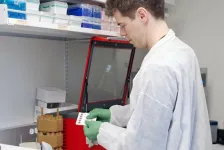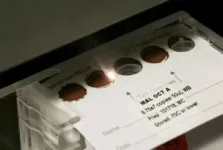(Press-News.org) Detecting malaria in people who aren’t experiencing symptoms is vital to public health efforts to better control this tropical disease in places where the mosquito-borne parasite is common. Asymptomatic people harboring the parasite can still transmit the disease or become ill later, after initially testing negative.
The dynamic lifecycle of this pathogen means that parasite densities can suddenly drop below the level of detection — especially when older, less sensitive tests are used. Such fluctuations can make it difficult, when testing only at a single point in time, to determine if an apparently healthy person is in fact infected.
Malaria can produce severe chills alternating with sweaty fevers, headaches, nausea and other distress. Yet many infected people can feel fine.
A recent asymptomatic detection study was conducted in the Katawki District, Uganda, which has a high incidence of malaria.
“We found that parasite dynamics and the parasite species present were highly variable among patients with low-level, asymptomatic infections,” said UW Medicine malaria research Dr. Sean C. Murphy, one of the senior scientists on the study. He noted that sampling every other day or every third day was enough to detect a proportion of infections similar to daily sampling. However, testing once a week or less often, even with sophisticated diagnostics, could misclassify the true infection status of up to one-third of the individuals.
This finding is important, Murphy said, for improving studies on the prevalence of malaria infection and, by extension, for clinical trials of malaria vaccines and therapeutics. Most of these trials use single-timepoint tests or repeated but infrequent tests to determine the infection status of asymptomatic participants. That approach is likely to miss infections if the participants’ parasite densities drop below the limit of the test employed.
Murphy is a physician-scientist and professor of laboratory medicine and pathology and microbiology at the University of Washington School of Medicine and chief of pathology and laboratory medicine at Seattle Children’s.
The project was a collaboration among the Murphy lab; Dr. Thomas Egwang and his research team including Tonny Owalla of Med Biotech Laboratories in Kampala, Uganda; and Dr. Jennifer E. Balkus, professor of epidemiology at the UW School of Public Health. Dr. Dianna E. B. Hergott, who was at the time a graduate student mentored by Murphy and Balkus, and Med Biotech’s Owalla led the study.
The Uganda-based team performed the community-based portions of the study. The participants were healthy, nonpregnant adults, ages 18 to 59, who were not taking antimalarial drugs, as well as older children, ages 8 to 17.
“We instructed participants in how to collect one dried blood spot at home every day for up to 29 days,” Owalla explained. The participants would come to the study clinic once a week to turn in that week’s blood spots, obtain new blood spot cards, and have traditional blood draws.
Diagnostic tests checked the dried blood spots for the presence, classification and densities of Plasmodium ribosomal RNA, which helps produce parasite proteins. The testing strategy also employed “pooling” of the dried blood spots. This approach allowed the team to test more samples cost-effectively, much like the strategies employed at the height of the COVID-19 pandemic.
By analyzing the resulting data, the researchers hoped to discern a sampling schedule comparable to testing every day to reliably identify asymptomatic cases, but less burdensome. On the other hand, the study team wanted to avoid a schedule that was too infrequent and that would end up missing infections.
The scientists categorized the infection trajectory of each participant: no infection whatsoever, newly detected infection, cleared infection, chronic infection, or not able to determine. Looking at the daily results, they also calculated how many infections would still have been detected if the sampling frequency were reduced.
About 60% of all the participants had a Plasmodium infection discovered at some point during the monthlong study. Fewer than half had an infection detected at the study’s outset. The lowest daily report during the study period showed a prevalence of 30%.
The findings are reported today, Jan 4, in The Lancet Microbe.
Earlier, several other studies questioned the accuracy of a single measurement to identify infection status. Undetected asymptomatic infections could inadvertently influence research results.
“Serial testing,” the paper authors suggested, “should be considered when trying to determine the true infection status of an individual.”
One of the limitations of their own study, the authors said, was that participants were not asked to collect their dried blood samples at the same time each day. Parasite densities, they noted, could change by as much as 100-fold during a six-hour span.
Owalla is now a graduate student in pathobiology at the UW School of Public Health. He plans to apply his training to further develop advanced solutions for malaria in Africa, the continent most severely affected by this disease.
Grants from the U.S. National Institutes of Health (R21AI146763) and the Bill and Melinda Gates Foundation (INV-009313) supported this research. The scientists declared no competing interests.
END
Classifying the natural history of asymptomatic malaria
Dynamic, fluctuating levels of this parasite in people without symptoms argues against single-point testing to diagnose infections
2024-01-05
ELSE PRESS RELEASES FROM THIS DATE:
New images reveal what Neptune and Uranus really look like
2024-01-05
Under embargo until 00:01 GMT on Friday 5 January 2024 /19:01 ET Thursday 4 January 2024
Royal Astronomical Society and University of Oxford press release
Neptune is fondly known for being a rich blue and Uranus green – but a new study has revealed that the two ice giants are actually far closer in colour than typically thought.
The correct shades of the planets have been confirmed with the help of research led by Professor Patrick Irwin from the University of Oxford, which has been published today in the Monthly Notices of the Royal Astronomical Society.
He and his team found that both worlds ...
Students build science identity through immersive research experience
2024-01-05
Each summer, community college students from Colorado and surrounding states converge on the CU Boulder campus to participate in an immersive nine-week research program. A recent CIRES-led study reveals that when the students head home, they don’t just take new scientific and professional skills with them—they also leave with more confidence in their ability to do science and a greater sense of belonging in the science community. The work, published last month in PLOS ONE, suggests that authentic research experiences inspire community college students’ interest in STEM careers.
“Paid, ...
Bipolar disorder linked to early death more than smoking
2024-01-04
Having bipolar disorder – a serious mental illness that can cause both manic and depressed moods – can make life more challenging.
It also comes with a higher risk of dying early. Now, a study puts into perspective just how large that risk is, and how it compares with other factors that can shorten life.
In two different groups, people with bipolar disorder were four to six times more likely as people without the condition to die prematurely, the study finds.
By contrast, people who had ever smoked were about twice as likely to die prematurely than those ...
Most babies with sickle cell disease face double disadvantage
2024-01-04
As if starting life with a potentially disabling genetic blood disease wasn’t enough, a study shows that almost two-thirds of babies born with sickle cell disease are born to mothers who live in disadvantaged areas.
But the study shows wide variation between states in the rate of births of babies with sickle cell to residents of areas with crowded housing, limited transportation options and other characteristics.
The researchers say their data could help public health authorities focus efforts to support the complex needs of children with sickle cell disease and their families.
The ...
Study shows liraglutide results in increased insulin sensitivity independent of weight loss
2024-01-04
A new study published in the journal Diabetes demonstrates that a glucagon-like peptide-1 receptor (GLP-1R) agonist, a member of a class of medication used to treat Type 2 diabetes and obesity, can lead to a rapid improvement in insulin sensitivity.
Insulin sensitivity is how responsive cells are to insulin, an essential hormone that controls blood glucose levels. An increase in insulin sensitivity means insulin can more effectively lower the blood glucose. Reduced insulin sensitivity or insulin resistance is a feature of Type 2 diabetes. Thus, improved ...
YAP and TAZ: Protein partners identified as potential key for fetal bone development
2024-01-04
A pair of proteins, YAP and TAZ, has been identified as conductors of bone development in the womb and could provide insight into genetic diseases such as osteogenesis imperfecta, known commonly as “brittle bone disease.” This small animal-based research, published today in Developmental Cell and led by members of the McKay Orthopaedic Research Laboratory of the Perelman School of Medicine at the University of Pennsylvania, adds understanding to the field of mechanobiology, which studies how mechanical forces influence biology.
“Despite more than a century of study on the mechanobiology of bone development, the cellular and molecular ...
Skin-deep resilience: Hidden physical health costs for minority youth overcoming adversity
2024-01-04
Urbana, Ill. – When youth thrive despite difficult circumstances, they are usually lauded for their accomplishments. However, overcoming adversity may have a hidden physiological cost, especially for minority youth. A new study from the University of Illinois Urbana-Champaign looks at physiological changes among high-striving minority youth in early adolescence.
“In the past decade, researchers have observed a phenomenon termed ‘skin-deep resilience.’ Historically, youth from disadvantaged backgrounds who ‘beat the odds’ were assumed to have universally positive outcomes. They are achieving academically, avoiding problematic behaviors, and scoring well on ...
Early nerve intervention reduces pain and complications after amputation
2024-01-04
Waltham — January 4, 2024 — Performed early – at the time of amputation – a procedure called targeted muscle reinnervation (TMR) can reduce pain scores and prevent complications related to abnormal nerve regrowth, suggests a study in the January issue of Plastic and Reconstructive Surgery®, the official medical journal of the American Society of Plastic Surgeons (ASPS). The journal is published in the Lippincott portfolio by Wolters Kluwer.
"Our experience suggests that that acute TMR reduces neuroma formation, and lowers the incidence of both phantom ...
Seizures identified as potential cause of sudden unexplained death in children
2024-01-04
In a study designed to better understand sudden, unexpected deaths in young children, which usually occur during sleep, researchers have identified brief seizures, accompanied by muscle convulsions, as a potential cause.
Experts estimate in excess of 3,000 families each year in the United States lose a baby or young child unexpectedly and without explanation. Most are infants in what is referred to as sudden infant death syndrome, or SIDS, but 400 or more cases involve children aged 1 and older, and in what is called sudden unexplained death in children (SUDC). Over half of these children are toddlers.
The study findings come from a registry of more than 300 SUDC cases, set up ...
Where’s the snow? Northeastern cities see record temps, low snowfall in 2023
2024-01-04
CORNELL UNIVERSITY MEDIA RELATIONS OFFICE
FOR RELEASE: Jan. 4, 2024
Kaitlyn Serrao
607-882-1140
kms465@cornell.edu
Where’s the snow? Northeastern cities see record temps, low snowfall in 2023
ITHACA, N.Y. - In the Northeastern United States, warming average temperatures for most all climate data sites in December 2023 ranged from 3.6 to 9 degrees Fahrenheit above normal – making 2023 the warmest year on record for 13 of the region’s 35 major locations, including New York City.
A total of 28 cities in the region saw one of their top-five warmest years, according to a report Jan. 2 ...
LAST 30 PRESS RELEASES:
Tracing the quick synthesis of an industrially important catalyst
New software sheds light on cancer’s hidden genetic networks
UT Health San Antonio awarded $3 million in CPRIT grants to bolster cancer research and prevention efforts in South Texas
Third symposium spotlights global challenge of new contaminants in China’s fight against pollution
From straw to soil harmony: International team reveals how biochar supercharges carbon-smart farming
Myeloma: How AI is redrawing the map of cancer care
Manhattan E. Charurat, Ph.D., MHS invested as the Homer and Martha Gudelsky Distinguished Professor in Medicine at the University of Maryland School of Medicine
Insilico Medicine’s Pharma.AI Q4 Winter Launch Recap: Revolutionizing drug discovery with cutting-edge AI innovations, accelerating the path to pharmaceutical superintelligence
Nanoplastics have diet-dependent impacts on digestive system health
Brain neuron death occurs throughout life and increases with age, a natural human protein drug may halt neuron death in Alzheimer’s disease
SPIE and CLP announce the recipients of the 2025 Advanced Photonics Young Innovator Award
Lessons from the Caldor Fire’s Christmas Valley ‘Miracle’
Ant societies rose by trading individual protection for collective power
Research reveals how ancient viral DNA shapes early embryonic development
A molecular gatekeeper that controls protein synthesis
New ‘cloaking device’ concept to shield sensitive tech from magnetic fields
Researchers show impact of mountain building and climate change on alpine biodiversity
Study models the transition from Neanderthals to modern humans in Europe
University of Phoenix College of Doctoral Studies releases white paper on AI-driven skilling to reduce burnout and restore worker autonomy
AIs fail at the game of visual “telephone”
The levers for a sustainable food system
Potential changes in US homelessness by ending federal support for housing first programs
Vulnerability of large language models to prompt injection when providing medical advice
Researchers develop new system for high-energy-density, long-life, multi-electron transfer bromine-based flow batteries
Ending federal support for housing first programs could increase U.S. homelessness by 5% in one year, new JAMA study finds
New research uncovers molecular ‘safety switch’ shielding cancers from immune attack
Bacteria resisting viral infection can still sink carbon to ocean floor
Younger biological age may increase depression risk in older women during COVID-19
Bharat Innovates 2026 National Basecamp Showcases India’s Most Promising Deep-Tech Ventures
Here’s what determines whether your income level rises or falls
[Press-News.org] Classifying the natural history of asymptomatic malariaDynamic, fluctuating levels of this parasite in people without symptoms argues against single-point testing to diagnose infections




